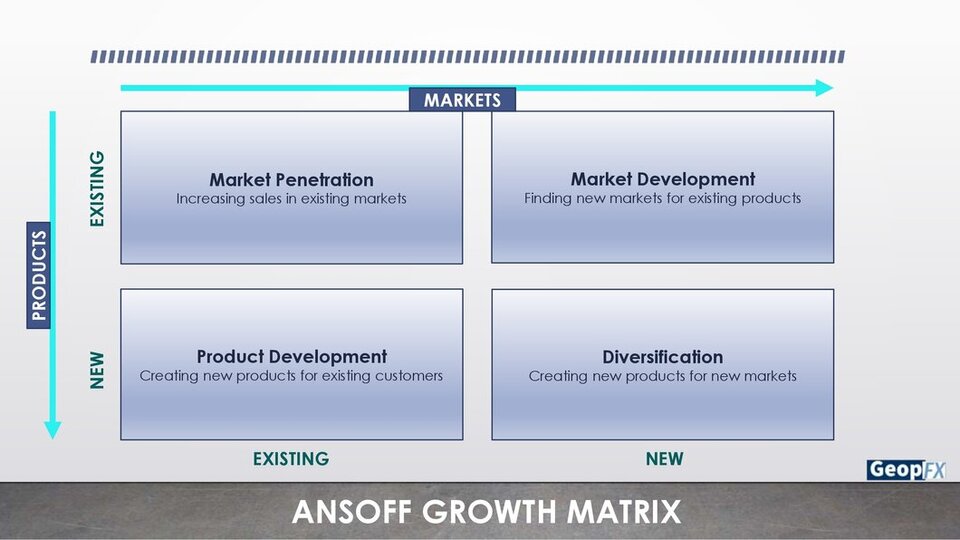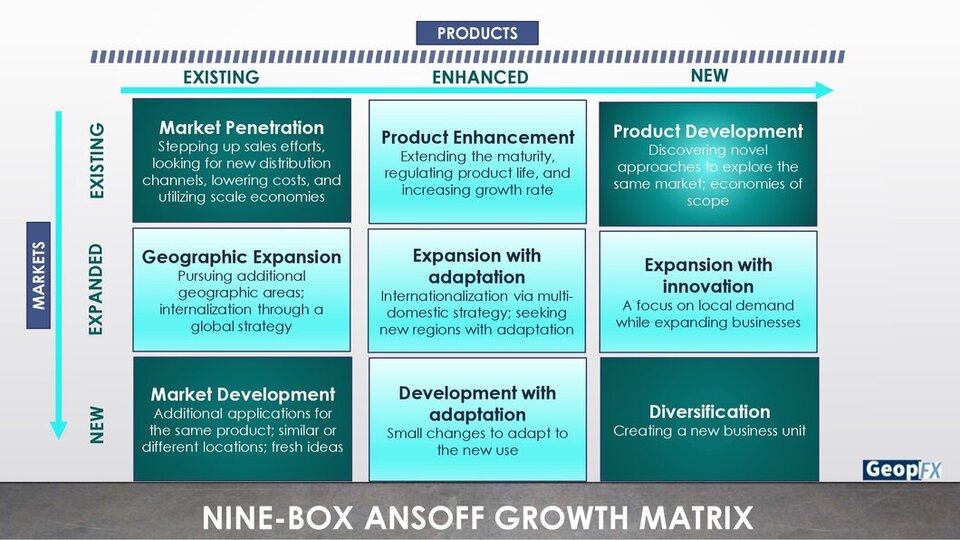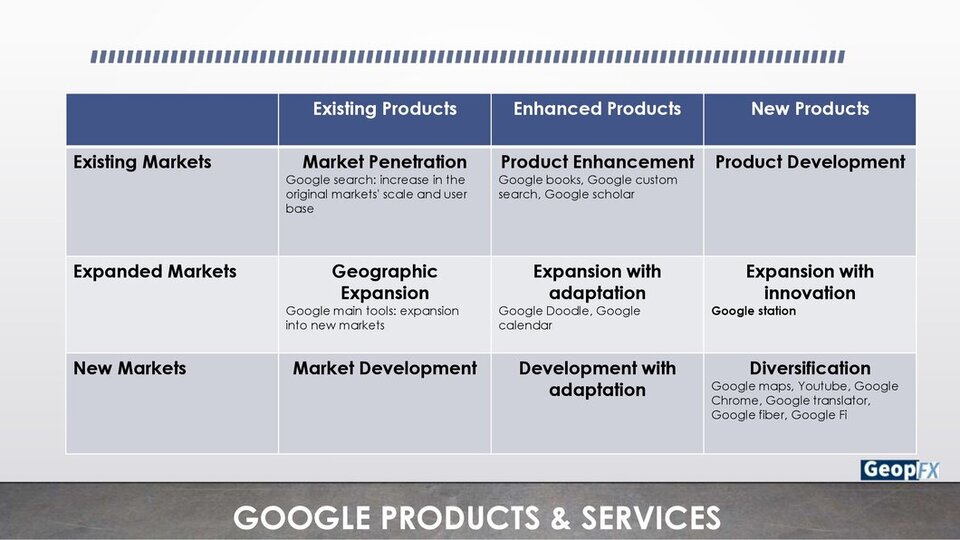The Ansoff Growth Matrix described the concept of strategy as the unifying factor between an organization’s operations and target product markets that identifies the fundamental character of the organization’s current or intended future path. The definition placed emphasis on the approach’s similarity across various organizational behaviors. Businesses and organizations are created around the products and services that define their value propositions.

A natural companion to the competitive advantage is the synergy component of strategy. This requires that opportunities within the scope possess characteristics which will enhance synergy.
Igor Ansoff
A company’s internal focus, which includes its strategic position, resources, and capabilities, as well as its external focus, which includes environmental opportunities and risks, are all part of strategic management. The idea that excellent strategic thinking can contribute to a significant amount of success leads to the necessity for strategic management.
| Content |
| What is Ansoff Growth Matrix |
| Strategy selection for product market growth |
| Ansoff Matrix: Extending the concept |
| Application of Expanded Ansoff’s Growth Strategies |
| Conclusion |
What is Ansoff Growth Matrix
Ansoff’s product/market grid examines two important dimensions, the product and the market, and four growth strategies are established by combining these two dimensions. These include product development, market development, market penetration, and diversification strategies.

A business can adopt each of the above strategies in order to achieve future growth. A progressive, well-run business would typically pursue multiple of them simultaneously, and this may be necessary for survival in the face of fierce economic competition.
Strategy selection for product market growth
To apply the Ansoff growth matrix, one must first align around the business objectives that are being pursued. Is the product brand-new or already in existence? The strategy—and the ensuing risks—will largely depend on the maturity, present situation, and long-term roadmap of the organization. Additionally, it depends on how much risk a company is now prepared to—or able to—accept.
Plotting strategic options into the appropriate quadrant should be the first step. Then, take a look at the risks connected to each one, and create a contingency plan to handle the most likely risks. The optimal decision for the organization will be made with the help of this risk analysis. Here is a look at each Ansoff matrix strategic strategy.
Market Penetration
Selling your existing products to your existing markets is called a Market Penetration strategy. A market penetration quadrant of the Ansoff matrix determines how to promote and distribute existing products and services more aggressively to existing customers. The company attempts to enhance its market share in the current market scenario by employing this strategy.
Benefit
Given that it makes use of many of the company’s existing products, this strategy carries a low risk.
Drawback
A market penetration plan is by its very nature a restricted strategy for long-term, high-growth businesses. A business should eventually outgrow a market penetration approach and switch to a more ambitious strategic course to maintain growth.
Product Development
When a business sees an opportunity, it may be a smart idea to develop new products to suit customer needs, even though doing so can be riskier than acquiring entry to the market. With a strong brand and a large presence in a competitive market, where continuous innovation is essential to avoid obsolescence, a strong R&D and/or proprietary technologies, helps new products to stand out.
Benefit
Companies can develop products that directly meet client requirements and expand their business by observing what is already successful and listening to customer feedback.
Drawback
Development of new products is inherently risky. New technology or production methods must also be heavily invested in up front for new product development. Companies should prepare for delays and rising costs.
Market Development
The company faces additional risks due to market development because it involves entering uncharted markets. Along with the company’s core competences for its current products, it also needs excellent marketing skills. The business will have options to reinvent the brand, investigate new applications for the product, or expand to other areas.
Benefit
This approach offers a substitution for risky and expensive product development approaches.
Drawback
The requisite knowledge and abilities to advance in an unfamiliar market with unfamiliar users may be lacking in market developers.
Diversification
The most risky strategy is diversification since it requires the organization to acquire new resources and competencies while simultaneously producing new products and entering new markets. The diversification plan typically calls for new skills and almost always results in structural and organizational changes to the company, which marks a clear divergence from prior business experiences.
Benefit
With the help of diversification, you can capture untapped markets, set yourself apart from the competitors, or even own underserved markets.
Drawback
The riskiest approach in the Ansoff matrix is diversification since it implicitly accepts untested area. Companies using this growth strategy frequently have to go forward without any prior knowledge of the market or a plan for growing the product or service to satisfy customer demand. With the right kind of diversification, you can capture untapped market share or set your business apart from the competitors.
Extending the concept
The nine-box matrix enables comparison of new and existing markets, products, and services.
This matrix is helpful because it distinguishes between product extension and true product development, as well as between market growth and actually entering new markets. The nine-box Ansoff growth matrix has the potential flaw that some of the grid parts involve two different strategic stances, making it challenging to distinguish your product or service or specify your ideal market share.

Application of Expanded Ansoff’s Growth Strategies
Google created a diverse range of products and services, some of which were quite successful. We can better comprehend Google’s efforts to increase its revenue and create new businesses by using the extended Ansoff Matrix. The Ansoff Matrix helps management in designing new initiatives that take into account diversification in both axes, markets and products, or both at once.
Google made investments in new products for its existing customers right from the start of its growth, which is consistent with Strategy 3: Product Development. These customers already used the company’s primary tool, the search engine, so it began to offer new products to its users in order to meet their evolving needs. By doing this, it prevented competitors from entering the market and potentially endangering it with the creation of specialized services and products.

In addition to Google Search, the “general” search engine, there are a number of different search tools, including Google Scholar for searching scholarly papers, Google Books for finding entire texts from books, and Google Custom Search, which enables users to make customized searches for their websites. They serve as exemplary illustrations of Strategy 2’s Product Enhancement, which aims to meet certain market demands by incorporating crucial new features into the original product.
Google also focused on generating new products for new markets, which is consistent with Strategy 9 in the Matrix – Diversification’s lower right corner. Despite having different features and ways of operating, the Google Maps business model is the same: selling ads, in this case enhanced with geolocation. Google Maps competed in the market, surpassing these competitors with products that explored the potential of mobile devices. Google acquired YouTube in 2006 as part of its drive to provide new products to new markets while enhancing its search algorithms and utilizing the same lucrative business model.
A typical endeavor related with Strategy 4, Geographic Expansion, the organization attempted to expand its footprint in other areas while using the same technologies. Despite the fact that this approach was generally successful, Google ran into issues in 2010 when it was blocked from China.
In order to better satisfy customers in various parts of the world, Google frequently implements Strategy 5, Expansion with Adaptation. Google frequently mentions national holidays and cultural events on its home page, and after multiple failed attempts to remain in China, the tool underwent a number of adjustments.
Conclusion
The Ansoff Matrix is still regarded as a conceptual framework helpful for developing market strategies more than fifty years after its original invention. The development and implementation of appropriate strategies will be even more crucial in more competitive, dynamic, and volatile sectors and markets. According to Ansoff, developing a strategy is not difficult; the real difficulty lies in making it effective.
However, the most significant contribution the Ansoff-Kotler-created Product-Market Matrix makes is a set of rules for managers of various organizations around the world. The example of Google provided here can aid in both a better understanding of this tool and in motivating leaders to foster an entrepreneurial spirit inside their organizations in search of new revenue streams and professional success.
